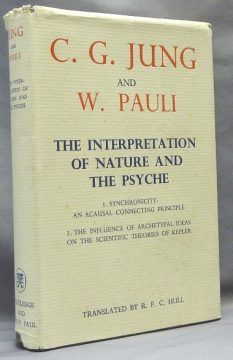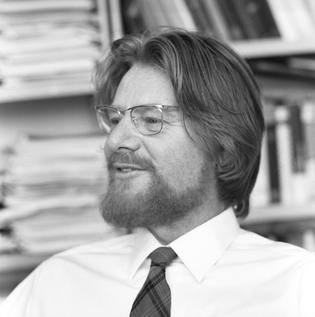by David Kordahl

Paul Halpern’s new book, Synchronicity: The Epic Quest to Understand the Quantum Nature of Cause and Effect, takes its time to get there, but its best parts discuss the intersection of two puzzles for 20th century rationalists: psychoanalysis, and quantum mechanics. This intersection is dramatized by the correspondence of Carl Jung, Freud’s influential protege, and Wolfgang Pauli, the physicist whose “exclusion principle” provides the quantum explanation for why matter doesn’t simply collapse. Halpern situates the Jung/Pauli dialogue in a broad-strokes science history. The first 120 pages roam from ancient Greece to modern physics. Then we get the interesting hundred-odd pages on Jung and Pauli. Finally, unconvincingly, John S. Bell and his famous theorem are described in terms of Jungian synchronicity.
This hook could work for a popular history, but already in the introduction, I realized this book wasn’t for me. Halpern has written an unabashedly Whig history, picking winners and losers, judging historical figures largely on whether they agree with the opinions of modern researchers. “Many great thinkers over the ages have conflated valid, testable scientific connections with pseudoscientific analyses,” he writes, confidently picking out the “specious numerology” of the Pythagoreans and the astrological impulses of Kepler as examples.
There’s nothing exactly wrong with this—I’m not going to the ropes for the numerologists—but it does call into question why we should care about this history. In a sort of thesis statement for the book, Halpern chides,
In retrospect, Jung’s insights about the need for a new acausal principle in science were brilliant and prescient. Nonetheless his low threshold for accepting anecdotal evidence about ‘meaningful coincidences’ without applying statistical analysis to rule out spurious correlations was a serious failing in his work. Jung trusted his intuitive sense of when things were connected. But in the light of the mind’s capacity to fabricate false linkages at times, pure intuition on its own is not genuine science.
This is all perfectly reasonable, but it misses the point.
Is Jung’s importance really limited to how well his language prefigured that of later discussions of quantum entanglement? Might not his widespread influence point to the possibility that Jung was on to something else?

Halpern is a fluent and friendly writer, and Synchronicity lays out the various wrong positions of the ancients in a briskly readable way. The idea that light has something to do with causal connections is traced from Empedocles to Einstein, and Halpern does a good job of leavening his well-worked dough with modern examples. In the part on special relativity, where we are reminded how events can be reordered so long as causes always precede effects, Halpern cuts in with the example of OPERA (Oscillation Project with Emulsion-tracking Apparatus), the experiment whose errors led to a false claim that neutrinos travel faster than light.
After a chapter on the birth of quantum mechanics, we finally arrive at Jung and Pauli. Carl Jung, whose ideas about archetypes and meaningful coincidences had an enormous influence over the wider culture, was the more glamorous of the two. (In A Dangerous Method, he was portrayed by Michael Fassbender.) While some intellectuals may dream of being Jung, with his puzzling detours into the unknown, few would want to be Pauli, who solicited Jung for therapy after his wife left him for a chemist.
Pauli’s harshness toward other physicists was legendary (“not even wrong,” a criticism Pauli leveled toward a student theory, has a physics blog named after it), so I was surprised to encounter the sensitive, doubtful man whose unusually mathematical dream journals Jungians continue to study. Though he began as a patient, Pauli eventually collaborated with Jung, contributing a historical consideration of Kepler to the book in which Jung’s “Synchronicity: An Acausal Connecting Principle” first appeared.

But I shouldn’t have been surprised. After all, I had read other examples of what might be classified under paranormal quantum literature—for instance, Arthur Koestler’s every-other-chapter discussion of quantum physics and parapsychology, The Roots of Coincidence. What Halpern contributes here is a historical understanding that many 20th-century scientists took a keen interest in experiments involving “extrasensory perception” (ESP), including Einstein himself, who contributed an introduction to Upton Sinclair’s book on telepathy, Mental Radio. In an era when basic questions about science were being reexamined, claims seeming to conflict with traditional science could be taken seriously. Empirical research, at such a time, was expected to astonish.
During his collaboration with Jung, Pauli followed the ESP experiments of the American botanist J.B. Rhine, and Jung went even farther. “The Rhine experiments have demonstrated that space and time, and hence causality, are factors that can be eliminated,” claimed Jung in 1951, “with the result that acausal phenomena, otherwise called miracles, appear possible.”
Miracles! Few of today’s physicists would want it sully quantum mechanics by associating it with the inexplicable. Neither does Halpern, who quotes Martin Gardner’s criticisms of parapsychology, and insists, “The field of psychology has since become far more exacting in its emphasis on controlled conditions and rigorous statistical methods.” Yet this places a period where science gives an ellipsis. As Freeman Dyson pointed out, many of the claims of parapsychology lie well outside the realm of solid science. Anyone expecting an easy debunking may be troubled by the recent Joy of X podcast where Brian Nosek suggests parapsychological experiments should be quashed just by setting up Bayesian priors such that their statistical significance can’t be claimed.
Pauli died fairly young (aged 58, in 1958), so it’s unclear whether Jung and Pauli stopped corresponding, or whether their correspondence was just cut short. For the question of quantum mechanics and causality, this hardly matters. The issues that Halpern raises in the last chapters of the book, after Pauli and Jung have shuffled off, seem to me to be where a more serious book on quantum mechanics and causality might have begun.

Halpern wants to celebrate the legacy of Jung and Pauli as a precursor to the work on quantum nonlocality that was pioneered by John S. Bell. “A broad definition of synchronicity as any acausal connecting principle,” he writes, “encourages exploration of how the universe is intertwined through symmetry and additional mechanisms of cause and effect.”
Bell was an accelerator specialist at CERN whose investigations in the foundations of quantum mechanics reawakened physicists to the philosophical issues at hand. In the 1960s, he showed how quantum descriptions inevitably lead to nonlocality—that is, to situations where elements of a system may be spatially separated, yet inextricably correlated. Experimental tests of Bell’s idea have usually involved an excited atom that spits out two photons traveling in opposite directions. Measuring the polarization of one of the photons instantaneously affects what predictions one might make on the other, regardless of their spatial separation at the time of measurement. Bell’s theorem expresses an inequality quantifying how the correlated measurements differ from those that would arise if the spatially separated particles were independent.
Whether or not Bell’s theorem expresses something spooky about physics remains controversial among physicists. Those who accept that there’s something fundamentally chancy about quantum measurements tend not to get too excited, as Bell’s theorem is absolutely in line with standard quantum theory. The physicists who are most disturbed by it are those who, like Bell, become convinced that standard quantum theory is a bit rotten.
Regardless of one’s position on Bell’s theorem, however, this discussion can progress perfectly well without Carl Jung. Synchronicity pitches itself as a book about quantum causality, but other recent books are more effective quantum primers. The book’s main value lies in its brief reviews of discarded visions. Scientific research involves the tacit assumption that explanations can be found, even if there’s no way to know in advance which ones will stick. Halpern flatly dismisses any hints of paranormal woo-woo, and in the conclusion reaffirms physics as “a magnificent tower of knowledge that stands miles above the mere speculations of our ancestors.” But any undecided reader who observe the past greats encountering unfamiliar explanations with openness may find themselves unsettled. The inquiries that will define 21st century science may remain to be discovered, and might, who knows, involve some discarded possibilities.
